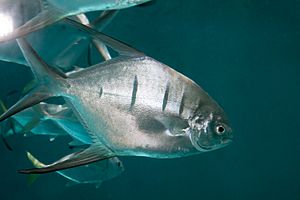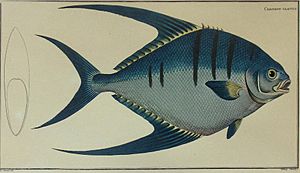Palometa facts for kids
Quick facts for kids Palometa |
|
|---|---|
 |
|
| Conservation status | |
| Scientific classification |
The Trachinotus goodei, also known as the palometa, is a cool ocean fish that lives in the Atlantic Ocean. It's a popular fish for game fishing. People also call it by many other names like banner pompano, cobbler, or longfin pompano. You can find this fish from Massachusetts all the way down to Argentina, including the Gulf of Mexico and the Caribbean Sea.
Contents
What the Palometa Looks Like
The palometa is easy to spot because of its long dorsal (top) and anal (bottom) fins. These fins have dark parts at the front. The dorsal fin usually has seven or eight stiff spines and 19-20 soft rays. The anal fin has two or three spines and 16-18 soft rays.
The color of the palometa can be different shades. Its head is usually gray to blue-green on top. Its sides are shiny silver and have four thin, dark lines going up and down. Sometimes, you can see a faint fifth line near its tail. The front part of its belly often has a bit of an orange color. Unlike many fish in its family, the palometa's tail does not have hard plates called scutes.
The biggest palometa ever found was about 50 cm (1 ft 8 in) long. The heaviest one weighed around 560 g (1 lb 4 oz).
Palometa's Life and Habits
Where They Live
Palometas like to live in clear, warm tropical waters. They prefer sandy beaches and bays. Sometimes, you can see them swimming together in groups above coral reefs.
Reproduction
Scientists don't know much about how palometas reproduce. They think these fish lay their eggs far out in the ocean during most of the year, except for winter. Young palometas have been shown to grow very quickly in special fish farms.
What They Eat
In the wild, palometas eat small creatures. Their diet includes worms, insect pupae (young insects), and smaller fish.
-
A palometa swimming near Bonaire.
Palometa and People
Palometas are mostly known as a game fish, meaning people like to catch them for sport. While some are raised in aquaculture (fish farming), not many are caught to be sold as aquarium pets. For example, only a couple of palometas were sent from Brazil for aquariums between 1995 and 2000.
There was a time on Christmas Day in 2013 when people swimming in the Parana River in Argentina were bitten by fish. The local people called these fish 'palometa'. About 70 people were bitten, and some even lost parts of their toes or fingers. However, the fish responsible for these bites were actually a type of piranha. In South America, 'palometa' is a general name used for many different kinds of fish, including some piranhas.
Fish farms in Florida have successfully raised palometas from eggs. These farm-raised palometas are becoming popular for large fish displays and public aquariums because of their interesting looks.
How the Palometa Got Its Name
The scientific name for this fish, goodei, honors an American scientist named George Brown Goode. He was an expert on fish and worked at the Smithsonian Institution. He was the first person to notice this type of fish in the waters of the United States. He lived from 1851 to 1896.
See also
 In Spanish: Palometa para niños
In Spanish: Palometa para niños





